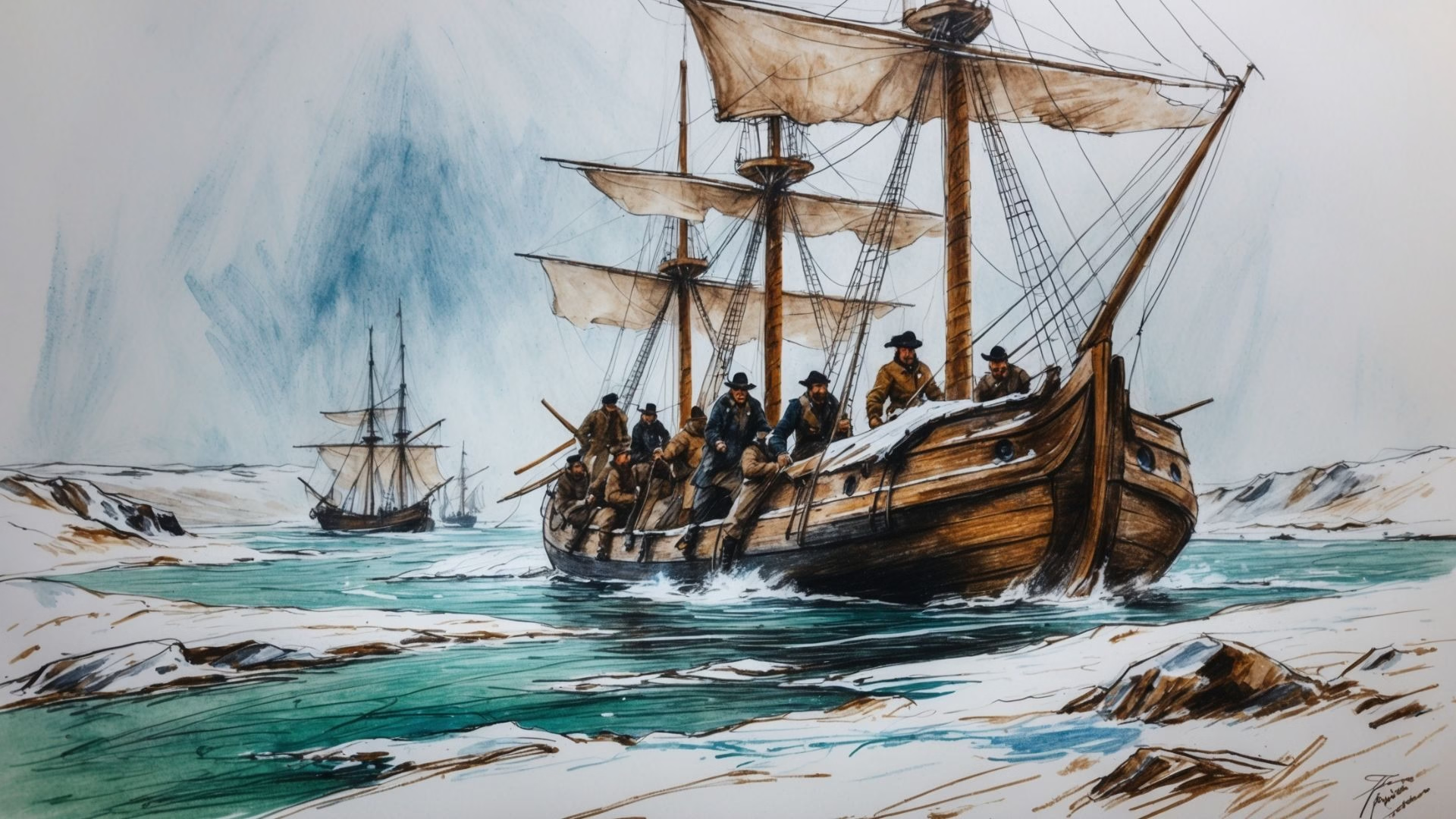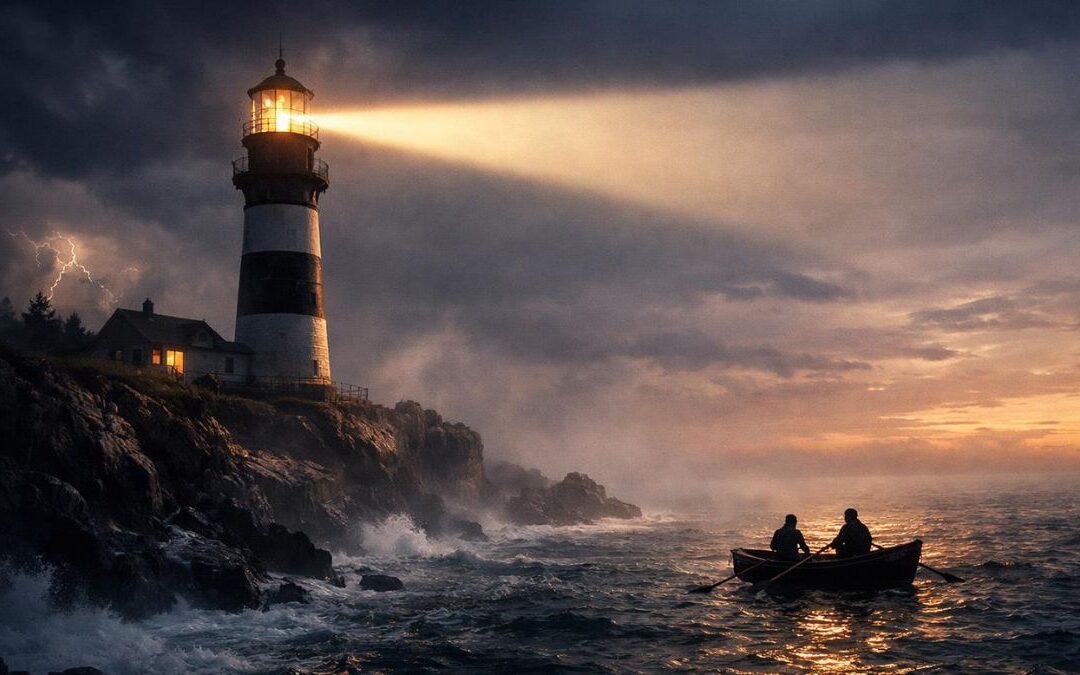- The Arctic’s Icy Embrace: Unraveling the Enduring Mystery of the Franklin Expedition
- Whispers from the Ice: Piecing Together the Grim Narrative
- Modern Revelations: Technology Unlocks Arctic Secrets
- Let’s Learn Vocabulary in Context
- Vocabulary Quiz
- Let’s Discuss
- Learn with AI
- Frequently Asked Questions
- 1. What was the primary goal of the Franklin Expedition and what made it unique among Arctic explorations of its time?
- 2. How did the search for the Franklin Expedition evolve, and what role did Lady Jane Franklin play in these efforts?
- 3. What were the initial theories proposed to explain the demise of the Franklin Expedition crew?
- 4. What evidence suggested cannibalism among the desperate crew, and how was this received by Victorian society?
- 5. When and how were the wrecks of HMS Erebus and HMS Terror finally discovered?
- 6. What insights have the discoveries of the wrecks provided about the expedition’s final days?
- 7. Why is the failure of the Franklin Expedition now understood as a “multifactorial catastrophe” rather than a single cause?
- 8. What is the enduring legacy of the Franklin Expedition today?
The Arctic’s Icy Embrace: Unraveling the Enduring Mystery of the Franklin Expedition
A Grand Undertaking: Ambition and the Northwest Passage
In the annals of exploration, few tales are as hauntingly persistent and utterly captivating as that of the Franklin Expedition. Imagine the year 1845. The British Empire, at the zenith of its global power, was not content with merely ruling vast swathes of the known world. Its gaze, ever ambitious, turned north, towards the elusive Northwest Passage – a fabled sea route through the Arctic archipelago that promised a faster, more efficient trade link to Asia. Numerous expeditions had attempted it, many failing, but none had vanished with such a complete and chilling finality as Sir John Franklin’s.
Franklin, a seasoned Arctic explorer with a mixed record of successes and near-fatal blunders (he was famously known as “the man who ate his boots” after a particularly harrowing earlier expedition), was chosen to lead this audacious venture. With two state-of-the-art ships, HMS Erebus and HMS Terror – fortified against ice, equipped with steam engines for auxiliary power, and boasting three years’ worth of provisions – the expedition was arguably the best-equipped polar undertaking of its time. A crew of 129 officers and men, brimming with Victorian confidence and a sense of imperial destiny, set sail from Greenhithe, England, on May 19, 1845, to much fanfare and public expectation. They were last seen by European whalers in Baffin Bay in late July. Then, silence. A profound, chilling silence that would echo for over a century and a half.
The Vanished Fleet: A Search for Answers Begins
Initially, there was little concern. Arctic expeditions were inherently dangerous, and a period of radio silence was not uncommon. But as years turned into a deafening silence, worry began to mount. Lady Jane Franklin, a woman of formidable will and unwavering devotion, became the driving force behind the search efforts. She leveraged her considerable influence and personal fortune, tirelessly campaigning for expeditions to locate her missing husband and his men.
From 1848 onwards, a veritable armada of search parties, both British and American, launched into the treacherous Arctic. These rescue missions, ironically, became significant feats of exploration in their own right, mapping vast stretches of previously uncharted territory. They discovered crucial clues: cairns (stone markers) with notes, abandoned campsites, and eventually, the first grim indicators of disaster. Graves on Beechey Island revealed that three crew members had died relatively early in the expedition, suggesting that all was not well from the outset. But the ships themselves, and the vast majority of the crew, remained stubbornly elusive. The mystery deepened, fueling public fascination and cementing the Franklin Expedition’s place as one of history’s most enduring enigmas.
Whispers from the Ice: Piecing Together the Grim Narrative
The early search efforts yielded tantalizing but incomplete fragments of the truth. It wasn’t until 1859 that Captain Francis Leopold McClintock, on an expedition funded by Lady Franklin, made the most significant discovery: a cairn on King William Island containing a note. This fateful “Crozier note,” named after Captain Francis Crozier (who had taken command after Franklin’s death), delivered a chilling summary. It stated that HMS Erebus and HMS Terror had been beset by ice in September 1846 and had remained trapped ever since. Sir John Franklin had died on June 11, 1847. The remaining 105 survivors, under Crozier’s command, abandoned the ships on April 22, 1848, attempting a desperate trek south towards the Back River, a known fur-trading route. The note also revealed that nine officers and 15 men had already perished. This grim communiqué confirmed the worst fears: the expedition had met with catastrophe.
The Scourge of Lead and Scurvy: Early Theories Emerge
With human remains and artifacts slowly being discovered by later expeditions and Inuit testimony, scientists began to unravel the potential causes of the disaster. Early examinations of bones revealed unusually high levels of lead. This led to the compelling theory that the expedition’s provisions, particularly the tinned food, were contaminated with lead solder, causing lead poisoning. Symptoms of lead poisoning include neurological damage, irritability, and cognitive impairment – hardly ideal conditions for navigating the unforgiving Arctic. Imagine a crew, already battling scurvy (a disease caused by Vitamin C deficiency, leading to weakness, bleeding, and eventual death) and the psychological toll of endless ice, also suffering from chronic poisoning that dulled their senses and decision-making. It’s a truly harrowing prospect.
Another significant factor was scurvy. Despite provisions of lemon juice (a known scurvy preventative), it appears either the supply was insufficient, or its efficacy was compromised. The physical degradation caused by scurvy would have severely hampered the men’s ability to pull heavy boats and sledges during their desperate overland retreat.
The Haunting Specter of Cannibalism: A Dark Chapter
Perhaps the most disturbing aspect of the Franklin mystery, and one that has sparked intense debate, is the evidence suggesting cannibalism. In 1854, explorer John Rae gathered testimony from Inuit who recounted seeing emaciated Europeans dragging boats and dying as they went. They also spoke of finding human remains with signs of dismemberment. Subsequent archaeological discoveries, particularly the examination of human bones found on King William Island and other sites, have corroborated these grim accounts. Cut marks and breakage patterns on bones are consistent with efforts to extract marrow and flesh. While a horrific testament to the extreme desperation faced by the dying crew, it is a stark reminder of the ultimate struggle for survival in the face of unimaginable adversity. This particular revelation sent shockwaves through Victorian society, for whom cannibalism was a barbaric taboo, threatening to tarnish the heroic image of British explorers.
Modern Revelations: Technology Unlocks Arctic Secrets
For over a century after McClintock’s discovery, the precise location of the ships remained a tantalizing enigma. The Arctic, ever guarded, kept its secrets well. However, advances in underwater technology, coupled with dedicated and meticulously planned search efforts by Parks Canada, finally began to yield concrete answers in the 21st century.
Erebus and Terror Found: The Final Pieces of the Puzzle
In 2014, a Parks Canada expedition, aided by Inuit knowledge and historical accounts, located the wreck of HMS Erebus in relatively shallow waters off King William Island. The discovery sent tremors of excitement through the archaeological and historical communities. Two years later, in 2016, the wreck of HMS Terror was found just 50 miles north of Erebus, in an even more pristine state of preservation, thanks to the extremely cold, dark, and oxygen-depleted waters. These discoveries were monumental, offering an unparalleled opportunity to study the ships and their contents, providing a literal window into the last days of the expedition.
The wrecks have yielded a treasure trove of artifacts – dishes, clothing, scientific instruments, and even personal effects – offering poignant glimpses into the lives of the doomed crew. The exceptional preservation of the ships, particularly Terror, with its masts still standing and much of its interior intact, promises to provide invaluable data on 19th-century shipbuilding and Arctic exploration.
A Multifactorial Catastrophe: No Single Smoking Gun
While the discoveries of the ships are monumental, they haven’t provided a single, definitive “smoking gun” for the expedition’s failure. Instead, the accumulating evidence points to a multifactorial disaster. It was likely a confluence of several devastating factors:
- Lead poisoning: Weakening the men and impairing judgment.
- Scurvy: Physically debilitating them.
- Harsh Arctic conditions: Prolonged ice entrapment, extreme cold, and dwindling supplies.
- Poor decision-making: Potentially exacerbated by lead poisoning and despair, leading to the disastrous overland trek.
- Inadequate understanding of Inuit survival techniques: A critical oversight, as the local inhabitants thrived where the Europeans perished.
The Franklin Expedition remains a stark cautionary tale of imperial hubris meeting the unforgiving power of nature. It’s a story of ambition, suffering, and ultimately, an extraordinary testament to human resilience in the face of unimaginable odds. The Arctic, once a silent tomb, has slowly begun to reveal its secrets, transforming a chilling enigma into a compelling narrative of human endeavor and ultimate tragedy. The exploration continues, both physical and intellectual, as researchers continue to pore over the wrecks and artifacts, hoping to piece together the final, elusive moments of Sir John Franklin and his lost expedition.
Let’s Learn Vocabulary in Context
When we delve into the gripping story of the Franklin Expedition, we encounter a lot of rich vocabulary that isn’t just for history buffs or Arctic explorers. These words can truly elevate your everyday conversations and writing. Let’s unpack a few of them.
First, let’s talk about annals. You often hear this word in phrases like “in the annals of history” or “the annals of science.” It refers to a historical record of events, usually arranged chronologically, like a very detailed, ancient diary or logbook. So, when we say the Franklin Expedition is in the annals of exploration, we’re emphasizing that it’s a significant, documented part of that historical record, a story that deserves to be remembered and studied. You could use it to describe the incredible achievements of a sports team: “Their perfect season will forever be etched in the annals of the league.” It adds a sense of historical weight and importance.
Next, we have zenith. This word literally means the point in the sky directly above an observer, but more commonly, it refers to the time at which something is most powerful or successful. So, when we talk about the British Empire being at its zenith, we mean it was at the peak of its power and influence. Think about your own peak performance: “After years of practice, the musician reached the zenith of his career.” It’s a powerful word to describe a high point, a moment of ultimate achievement or strength.
Then there’s audacious. This adjective describes someone or something showing a willingness to take surprisingly bold risks. Leading an expedition into the unknown, treacherous Arctic was certainly an audacious venture. It implies courage and daring, often in a way that pushes boundaries. You might describe an “audacious attempt to climb Mount Everest” or an “audacious marketing campaign” that takes a big gamble. It conveys a sense of fearless ambition.
Let’s move to formidable. This word means inspiring fear or respect through being impressively large, powerful, intense, or capable. Lady Jane Franklin’s will was formidable, meaning it was incredibly strong and commanding respect. A formidable opponent in a game, a formidable challenge in a project, or a formidable leader – all these convey a sense of impressive power or difficulty that demands attention. It’s a word that suggests something is not easily overcome.
Next up, we have veritable. This adjective is used as an intensifier, often to qualify a metaphor, to mean “being truly or very much so.” When we describe the search efforts as a “veritable armada,” it means it was truly like an armada – a large fleet of ships – even if it wasn’t officially one in a military sense. It emphasizes the sheer scale and intensity. You might say, “The party was a veritable feast,” meaning it was truly like a feast, with an abundance of food. It’s a great way to add emphasis and vividness to your descriptions.
Now, let’s consider elusive. This word means difficult to find, catch, or achieve. The missing ships remained stubbornly elusive for decades. It suggests something that continually evades capture or understanding. You might talk about an “elusive answer to a difficult problem” or an “elusive dream” that’s hard to grasp. It conveys a sense of something being just out of reach, adding a touch of mystery or frustration.
Then there’s compelling. This adjective means evoking interest, attention, or admiration in a powerfully irresistible way. The theory of lead contamination was compelling because it was so strong and convincing. A compelling argument, a compelling story, or a compelling reason – all these draw you in and make you pay attention. It suggests a powerful attraction or persuasive force.
Let’s discuss corroborated. This verb means to confirm or give support to (a statement, theory, or finding). The archaeological discoveries corroborated the grim accounts of cannibalism from the Inuit, meaning they provided independent evidence that supported those stories. It’s a crucial word in legal and scientific contexts, indicating that evidence lines up and strengthens a claim. You might say, “The witness’s testimony corroborated the police’s suspicions.”
Another key word is pristine. This adjective means in its original condition; unspoiled. The wreck of HMS Terror was found in a pristine state of preservation, meaning it was incredibly well-preserved, almost as if untouched. You can use it to describe anything that is perfectly clean, new, or untouched: “The untouched wilderness was pristine” or “She kept her vintage car in pristine condition.” It conveys a sense of perfection and unspoiled quality.
Finally, we have confluence. This noun literally refers to the junction of two rivers, but more commonly, it means an act or process of merging. So, when we talk about a “confluence of several devastating factors” leading to the Franklin expedition’s demise, we mean a coming together or merging of multiple negative elements. You might describe a city as a “confluence of cultures” or a successful project as the result of a “confluence of talent and hard work.” It’s a sophisticated way to describe multiple elements coming together, often to produce a significant outcome.
These words are not just for academic texts; they are powerful tools for expressing yourself with greater precision, elegance, and impact in any conversation. By incorporating them into your vocabulary, you’ll find your English becoming richer and more engaging.
Vocabulary Quiz
Let’s Discuss
- The Franklin Expedition is often described as a classic tale of “imperial hubris meeting the unforgiving power of nature.” How does this narrative resonate with other historical attempts at conquering extreme environments (e.g., early Everest expeditions, attempts to cross deserts)? What lessons can we draw from the Franklin Expedition about respecting environmental limits and the dangers of overconfidence in technology? (Consider discussing the role of national pride in driving exploration, the limitations of contemporary technology, and the importance of indigenous knowledge. Think about how modern exploration approaches differ.)
- Lady Jane Franklin played a pivotal role in instigating and funding the search efforts, transforming a personal tragedy into a sustained public campaign. How does her unwavering devotion and formidable will highlight the often-overlooked influence of women in historical events, even when they weren’t directly on the expedition? What does her story tell us about resilience and advocacy? (Discuss the social constraints on women in the Victorian era and how Lady Franklin navigated them. Explore the power of individual determination in shaping historical outcomes and inspiring future generations.)
- The discovery of the wrecks of HMS Erebus and HMS Terror in such a pristine state of preservation offers an unprecedented opportunity for archaeological study. What specific insights do you think these wrecks could provide that historical documents or human remains cannot? How might these discoveries change our understanding of the expedition’s final moments? (Consider the potential for understanding daily life on board, technological advancements, or the sequence of events. Discuss the ethics of disturbing well-preserved historical sites and the importance of conservation.)
- The article highlights a “multifactorial disaster” involving lead poisoning, scurvy, harsh conditions, poor decision-making, and inadequate understanding of Inuit survival techniques. If you were advising a modern polar expedition, which of these historical lessons would you emphasize most and why? How have contemporary expeditions adapted to mitigate such risks? (Discuss the importance of comprehensive health protocols, robust training, and genuine collaboration with local communities. Think about how modern communication and rescue capabilities have changed the landscape of polar exploration.)
- The evidence of cannibalism among the dying crew members sparked immense debate and discomfort in Victorian society, threatening to tarnish the heroic image of British explorers. How do such grim discoveries challenge romanticized historical narratives? Why is it important to confront the darker, more desperate aspects of historical events, even if they are uncomfortable? (Discuss the tension between historical accuracy and societal ideals. Explore how understanding extreme human behavior in survival situations can provide insights into human resilience and the breakdown of societal norms. Consider the role of primary sources and archaeological evidence in challenging established narratives.)
Learn with AI
Disclaimer:
Because we believe in the importance of using AI and all other technological advances in our learning journey, we have decided to add a section called Learn with AI to add yet another perspective to our learning and see if we can learn a thing or two from AI. We mainly use Open AI, but sometimes we try other models as well. We asked AI to read what we said so far about this topic and tell us, as an expert, about other things or perspectives we might have missed and this is what we got in response.
As an expert in historical mysteries, particularly those of polar exploration, I find the Franklin Expedition to be a perpetually rich subject. While our article covers the core aspects beautifully, I’d like to illuminate a few additional facets that add even more depth and nuance to this chilling saga.
Firstly, let’s talk about the provisions in more detail. The expedition was lauded for being “state-of-the-art,” particularly its tinned food. However, this very innovation may have been a fatal flaw. Beyond the lead contamination, the sheer novelty of tinned food meant there was little understanding of its long-term viability or the precise nutritional content after years at sea. Traditional Arctic diets, rich in fresh meat (and therefore Vitamin C), were essential for survival. The reliance on canned provisions, while seemingly advanced, detached the crew from the very survival techniques that had sustained indigenous peoples for millennia. This underscores a critical lesson: sometimes, the most sophisticated technology isn’t the best solution, especially when it replaces time-tested, local knowledge. It’s a classic example of technological hubris.
Secondly, the Inuit perspective is paramount and often wasn’t given its due weight in early searches. Long before European search parties found any physical evidence, the Inuit had seen the ships, interacted with the starving crew members, and later found their remains. Their oral histories provided incredibly accurate, albeit initially dismissed, accounts of the expedition’s demise, including details that later archaeological discoveries would corroborate. This highlights a critical bias in historical inquiry: the tendency to prioritize written European accounts over oral traditions of indigenous peoples. Had early searchers fully embraced and believed the Inuit testimonies, many answers might have been found much sooner, and indeed, more lives potentially saved in subsequent search efforts. Their survival strategies in the same brutal environment should have been the blueprint, not an afterthought.
Finally, consider the psychological toll of such an extended, trapped existence. Imagine being ice-bound for not just one winter, but two, then nearly three, with dwindling supplies, escalating illness, and the sun disappearing for months on end. The constant grind of despair, the breakdown of social order, and the erosion of hope would have been immense. This goes beyond the physical ailments like lead poisoning and scurvy. The sheer mental fortitude required, and ultimately, the complete collapse of morale, contributed significantly to their demise. The psychological dimension of polar exploration, the sheer isolation and monotony combined with existential dread, is a profound factor that often gets less attention than the more tangible physical causes of death. This human element, the slow unraveling of sanity and hope, is arguably the most poignant, albeit hardest to quantify, aspect of the Franklin tragedy. These subtle but profound aspects truly complete the grim mosaic of the Franklin Expedition.
Frequently Asked Questions
1. What was the primary goal of the Franklin Expedition and what made it unique among Arctic explorations of its time?
The primary goal of the Franklin Expedition was to discover and navigate the elusive Northwest Passage, a fabled sea route through the Arctic archipelago that promised a faster trade link to Asia. The British Empire, at the peak of its power in 1845, sought to expand its global reach and find an efficient trade route.
What made the Franklin Expedition unique was its unprecedented level of preparedness and state-of-the-art equipment. Led by seasoned explorer Sir John Franklin, the expedition comprised two highly advanced ships, HMS Erebus and HMS Terror. These vessels were specifically fortified against ice, equipped with steam engines for auxiliary power, and stocked with a prodigious three years’ worth of provisions. With a crew of 129 officers and men, it was arguably the best-equipped polar undertaking of its time, setting sail with immense public expectation. However, this impressive preparation ultimately made its complete disappearance all the more puzzling and tragic.
2. How did the search for the Franklin Expedition evolve, and what role did Lady Jane Franklin play in these efforts?
Initially, there was little concern when the Franklin Expedition ceased communication, as periods of radio silence were not uncommon in Arctic exploration. However, as years passed without any news, worry escalated. Lady Jane Franklin, Sir John Franklin’s wife, became the relentless driving force behind the search efforts. A woman of formidable will and unwavering devotion, she leveraged her considerable influence and personal fortune to tirelessly campaign for expeditions to locate her missing husband and his men.
From 1848 onwards, a vast array of search parties, both British and American, launched into the treacherous Arctic. These rescue missions, ironically, became significant feats of exploration themselves, mapping extensive previously uncharted territories. They yielded crucial clues such as cairns with notes and abandoned campsites, and eventually, the grim discovery of graves on Beechey Island, indicating early fatalities. Lady Franklin’s persistent advocacy was instrumental in maintaining public and governmental interest in the search, leading to critical discoveries like the “Crozier note” in 1859, which confirmed the expedition’s catastrophic fate.
3. What were the initial theories proposed to explain the demise of the Franklin Expedition crew?
Early examinations of human remains and artifacts, coupled with Inuit testimony, led to the development of several key theories regarding the expedition’s demise. Two prominent theories emerged:
- Lead Poisoning: Analysis of crew members’ bones revealed unusually high levels of lead. This suggested that the expedition’s provisions, particularly the tinned food, were likely contaminated with lead solder used in their packaging. Lead poisoning could have caused neurological damage, irritability, and impaired cognitive function, severely hindering the crew’s judgment and decision-making capabilities in the harsh Arctic environment.
- Scurvy: Despite the inclusion of lemon juice, a known scurvy preventative, it’s believed that the supply was either insufficient or its efficacy was compromised. Scurvy, caused by Vitamin C deficiency, leads to severe weakness, bleeding, and eventually death. The physical debilitation from scurvy would have significantly hampered the men’s ability to undertake strenuous activities like pulling heavy boats and sledges during their desperate overland retreat.
These factors, combined with the extreme cold and ice entrapment, painted a picture of a crew increasingly incapacitated and suffering from multiple ailments.
4. What evidence suggested cannibalism among the desperate crew, and how was this received by Victorian society?
Evidence suggesting cannibalism among the Franklin Expedition crew emerged through various sources. In 1854, explorer John Rae gathered chilling testimony from Inuit who recounted seeing emaciated Europeans dragging boats and dying, and spoke of finding human remains with signs of dismemberment.
Subsequent archaeological discoveries significantly corroborated these accounts. Examination of human bones found on King William Island and other sites revealed distinctive cut marks and breakage patterns consistent with efforts to extract marrow and flesh. While a horrific testament to the extreme desperation and ultimate struggle for survival, this particular revelation sent shockwaves through Victorian society. Cannibalism was considered a barbaric taboo, and the notion that esteemed British explorers might resort to such an act threatened to tarnish the heroic image of British imperial endeavor and cast a dark shadow over the expedition’s legacy.
5. When and how were the wrecks of HMS Erebus and HMS Terror finally discovered?
For over a century after Captain McClintock’s crucial discovery of the Crozier note in 1859, the precise locations of the two ships remained a tantalizing enigma. The Arctic successfully guarded its secrets. However, in the 21st century, significant advancements in underwater technology, combined with dedicated and meticulously planned search efforts led by Parks Canada, finally began to yield concrete answers.
- HMS Erebus: In 2014, a Parks Canada expedition, greatly aided by invaluable Inuit knowledge and historical accounts, successfully located the wreck of HMS Erebus. It was found in relatively shallow waters off King William Island, sending tremors of excitement throughout the archaeological and historical communities.
- HMS Terror: Just two years later, in 2016, the wreck of HMS Terror was discovered approximately 50 miles north of the Erebus site. This find was even more remarkable as the Terror was found in an exceptionally pristine state of preservation, attributed to the extremely cold, dark, and oxygen-depleted waters of its resting place.
These monumental discoveries offered an unparalleled opportunity to study the ships and their contents, providing a literal window into the last days of the ill-fated expedition.
6. What insights have the discoveries of the wrecks provided about the expedition’s final days?
The discoveries of HMS Erebus and HMS Terror have been monumental, offering an unprecedented opportunity to delve into the expedition’s final moments. While they haven’t provided a single “smoking gun,” they have offered invaluable insights:
- Artifact Preservation: The wrecks have yielded a treasure trove of artifacts, including dishes, clothing, scientific instruments, and personal effects. These items offer poignant, tangible glimpses into the daily lives of the doomed crew and the conditions they faced, providing a human element to the tragedy.
- Ship Preservation: The exceptional preservation of the ships, particularly HMS Terror with its masts still standing and much of its interior intact, is crucial. This provides invaluable data on 19th-century shipbuilding techniques and how such vessels were designed to withstand Arctic conditions. The condition of the ships suggests they were abandoned in a relatively orderly fashion, reinforcing the timeline of the desperate overland trek.
- Environmental Context: The locations and states of preservation of the wrecks also provide insights into the precise environmental conditions that trapped them. The fact that the Terror is so well-preserved suggests that it sank slowly, perhaps after being damaged by ice or intentionally scuttled after abandonment, rather than being violently crushed.
These discoveries continue to be a rich source of information, allowing researchers to piece together a more comprehensive narrative of the expedition’s final, tragic chapter.
7. Why is the failure of the Franklin Expedition now understood as a “multifactorial catastrophe” rather than a single cause?
The accumulating evidence from historical accounts, archaeological discoveries, scientific analysis of human remains, and the newfound wrecks points strongly to the Franklin Expedition’s failure being a “multifactorial catastrophe” rather than attributable to a single cause. It was a confluence of several devastating factors that collectively led to the expedition’s demise:
- Lead Poisoning: Weakened the men physically and mentally, impairing their judgment and decision-making capabilities.
- Scurvy: Severely debilitated the crew, hindering their physical strength and endurance, which were critical for survival in the extreme conditions and for the arduous overland trek.
- Harsh Arctic Conditions: Prolonged ice entrapment for over two years, extreme cold, and dwindling supplies created an increasingly desperate situation from which escape became progressively difficult.
- Poor Decision-Making: The decision to abandon the ships and undertake a desperate, ill-fated overland trek southward was likely exacerbated by the physical and mental effects of lead poisoning and scurvy, compounded by despair.
- Inadequate Understanding of Inuit Survival Techniques: A critical oversight. The European explorers, despite their advanced technology, lacked the crucial knowledge of how to live and thrive in the Arctic environment, a skill mastered by the local Inuit inhabitants. This made their “best-equipped” expedition ironically unprepared for true survival in the long term.
Thus, the expedition’s failure serves as a stark cautionary tale of imperial hubris meeting the unforgiving power of nature, where a combination of environmental challenges, disease, and human errors sealed its tragic fate.
8. What is the enduring legacy of the Franklin Expedition today?
The enduring legacy of the Franklin Expedition is multifaceted, extending beyond its immediate tragic outcome:
- A Haunting Enigma and Public Fascination: For over a century and a half, the expedition remained one of history’s most compelling and persistent mysteries. This fueled countless books, documentaries, and expeditions, cementing its place in popular culture as a cautionary tale of exploration and survival.
- Catalyst for Further Exploration: Paradoxically, the initial search efforts for Franklin’s lost expedition became significant feats of exploration in their own right, leading to the mapping of vast, previously uncharted territories in the Canadian Arctic.
- Scientific and Archaeological Significance: The recent discoveries of HMS Erebus and HMS Terror are monumental. They offer unparalleled opportunities for archaeological research, providing a literal window into 19th-century maritime technology, daily life aboard polar vessels, and the conditions faced by explorers. The exceptional preservation of the wrecks promises to yield invaluable scientific data for decades to come.
- A Cautionary Tale of Hubris: The expedition stands as a stark reminder of the unforgiving power of nature and the limitations of even the most advanced technology when confronted with extreme environments. It highlights the dangers of imperial overconfidence and the critical importance of adapting to local conditions, as evidenced by the contrast with Inuit survival techniques.
- Tribute to Human Endurance and Despair: The story, especially with the grim revelations of cannibalism, underscores the extreme lengths to which humans can be pushed in the ultimate struggle for survival, and the profound suffering endured by the crew.
In essence, the Franklin Expedition has transformed from a chilling enigma into a compelling narrative of human ambition, suffering, and the relentless quest for knowledge, continuing to captivate and inform us about the intersection of human endeavor and the raw power of the natural world.










0 Comments